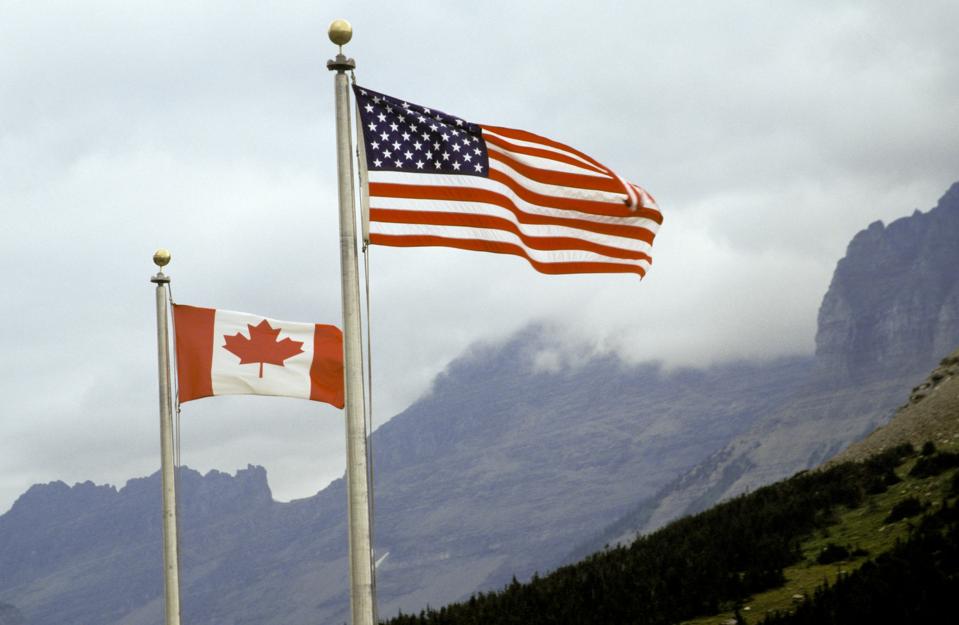Cross-border travel between the U.S. and Canada is collapsing and fast. Early signs of a slowdown emerged in March as Canadian travelers stayed away.
Now, based on new forward-booking data analyzed by OAG, a global travel data provider, summer flight bookings on Canada-U.S. routes are down more than 70% year-over-year.
In March 2024, U.S. travelers made more than 1.5 million flight bookings for the summer travel season. By March 2025, that number had plunged to just over 400,000. It is a staggering drop indeed.
Airlines have already pulled 320,000 airline seats from the schedule up to October 2025, and they are looking to add more seats for international flights instead.
The implications stretch far beyond airline revenue. While Canada was a relatively low-carbon, close-to-home travel option for U.S. tourists, this sudden collapse risks diverting travelers toward longer-haul, higher-emission alternatives.
U.S. Airlines Shift Gears, Add Thousands Of Seats To Europe
European hot-spots remain in high demand, even as travelers venture beyond the continent’s most iconic landmarks. Despite new overtourism measures already in place across several destinations this summer, U.S. airlines are ramping up their transatlantic capacity.
On March 18, OAG reported that all three major U.S. carriers will likely have double-digit growth in Italy this year, adding more than 260,000 seats to the transatlantic market.
While Iberia has scaled back capacity by 35,000 seats, its oneworld partner American Airlines is stepping in with an additional 75,000 for Spain travel.
Meanwhile, in the U.K., the second-largest international market for U.S. travelers after Mexico, carriers maintain the same 9.6 million scheduled seats in total.
Virtuoso, a global network of agencies specializing in luxury and experiential travel, reported that they have already seen a 473% increase in bookings for Slovenia, 356% for Croatia, 309% for the Czech Republic and 272% for Turkey for June, July and August.
Choosing Europe Over Domestic Travel Comes With A 5x Carbon Footprint Increase
Sustainability advocates should be alarmed if one of the lowest-carbon international travel corridors available to American tourists is replaced by transatlantic routes, which have a significantly greater impact on the carbon footprint.
A one-way economy class flight from New York (JFK) to Toronto (YYZ) — approximately 373 miles — generates an estimated 439 pounds (0.199 metric tons) of CO₂ per traveler as calculated via MyClimate.
Compared to that, a one-way economy class flight from New York (JFK) to London (LHR) — approximately 3,418 miles — generates an estimated 2,156 pounds (0.978 metric tons) of CO₂ per traveler.
In other words, choosing a transatlantic flight to London over a regional trip to Toronto increases a traveler’s carbon footprint by nearly five times. It can be a stark reminder of how destination choice alone can dramatically shape the environmental cost of travel.
As International Turbulence Grows, Should U.S. Travelers Turn Domestic?
On March 18, OAG reported that all three major U.S. carriers have increased capacity for summer travel: United by 8.4%, Delta by 7.3% and American by 5.5%. And the bulk of that growth is concentrated on domestic routes.
United Airlines alone is adding 8.3 million seats to its domestic network compared to just over one million additional seats internationally.
On February 6, 2025, the U.S. Bureau of Economic Analysis reported that the travel and tourism sector’s contribution to GDP edged up from 2.96% in 2022 to 3.03% in 2023.
More significantly, tourism-related employment surged to 10 million jobs in 2023, up from 9.1 million the previous year.
This uptick in both economic output and employment reflects a robust rebound after the pandemic. But, what happens to the sector and the employees if this 70% drop in summer bookings remain?
The situation might not be so dramatic. According to Bank of America’s latest analysis on domestic tourism published in March 2025, Americans themselves drive most of the U.S. tourism industry.
About two-thirds of all money spent on tourism in the U.S. comes from U.S. consumers. In contrast, foreign visitors contribute less than 10% to the overall tourism spending in the U.S.
Does this mean that if U.S. travelers keep traveling within the country, the tourism sector can weather any external distruptions, even in the face of declining international visitor numbers or shifting global travel trends? Time will tell.

